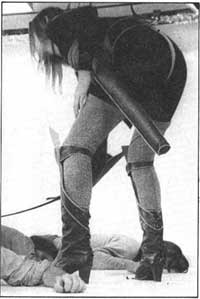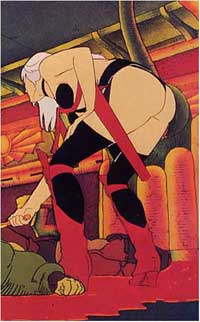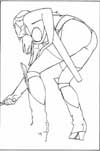Comics /
Cult Favorite
Rotoscope Animation
By Philip Schweier
July 3, 2003 - 15:23
Some people enjoy Japanese animation. I'm not one of them. I have nothing against Japanese people, I just don't care for the animated films as they have been presented to me. Perhaps something is lost in the translation. Perhaps I haven't seen enough to form an valid opinion. Or perhaps they exhibit some quality which fails to entertain or impress me.
But I'll never call it bad animation. Well, maybe some of it, but bad animation is not strictly a Japanese thing. Heaven knows American studios have churned out more than our fair share of garbage in the past 100 years of film.
So where can we draw the line between good and bad? I think it's when that line fails to be drawn at all that we enter the realm of bad animation. Or perhaps we should call it non-animation. Basic doodles by a high school student in the margins of his algebra text book represent the simplest animated endeavor. From there, the animation community gets more ambitious and more sophisticated at the same time, until finally leaving the realm of animation altogether and crossing over into another form of film making.
There is a process called rotoscoping. For those who are unfamiliar with it, it involves taking live action footage, say, of two people dancing, and basically tracing the figures frame by frame, so as to create a more true-to-life illusion of movement. It's a technique that Disney has used for decades, but the purpose has usually been to enhance the quality of the animated sequence, not to replace more traditional methods. Sometimes, the frames are reduced from 24 frames per second of live action footage to to 20 frames of animated footage, to alleviate the labor intensity while maintaining the smooth lifelike qualities.
 |
Unfortunately, some animators have come to use this process as a crutch, including simply using photographic distortion in lieu of generating the animated figures themselves. For instance, in some of Ralph Bakshi's feature films (Lord of the Rings and Fire & Ice come to mind), he uses film footage of live actors to be distorted, discolored, and dissected. It doesn't completely invalidate the film, but it does begin to bridge the gap between live action and animation.
But can such photo effects be considered animation at all? Doesn't animation come from a person, not a machine? If the answer is yes, then what about computer animation? Photography employs a device which captures on film a moment in time. The camera is a tool, and so is a computer. It allows the animator the ability to instill movement and the illusion of life, some quite effectively.
Some might claim that be it computer or camera, it's still a device creating the illusion, and not a person. Not necessarily. The similarity is that both instances require a human being to be in control of the device. The difference is that whether it is truly an ILLUSION of life. By photographing live action movement, it is not by its very name an illusion.
It's sometimes a hotly debated issue that will be resolved in time, just as jazz, once overlooked, is now a highly regarded form of musical expression. Just as there are various types of music, there are also various types of animation, from Pixar's computer-generated animation, to Ray Harryhausen's stop-motion photography. Who is to say which is legitimate animation, and which is not?
Some will insist that art must reflect beauty, or that film, animated or live action, serve to entertain. We are all different from each other, and those differences result in an endless variety of sensibilities and interests. So just by our nature as human beings, no film, animated or otherwise, is going to entertain everyone. Ergo, what is art to one will not be art to another.
I offer one qualifying factor: Truth.
If an animated sequence is labelled as such, when in fact it is photographic in nature, it is misrepresentational. We are taught from early childhood that lying is bad, and with that thought in mind, we may be able to define bad animation as that which isn't animated at all.
Last Updated: March 3, 2025 - 20:40


